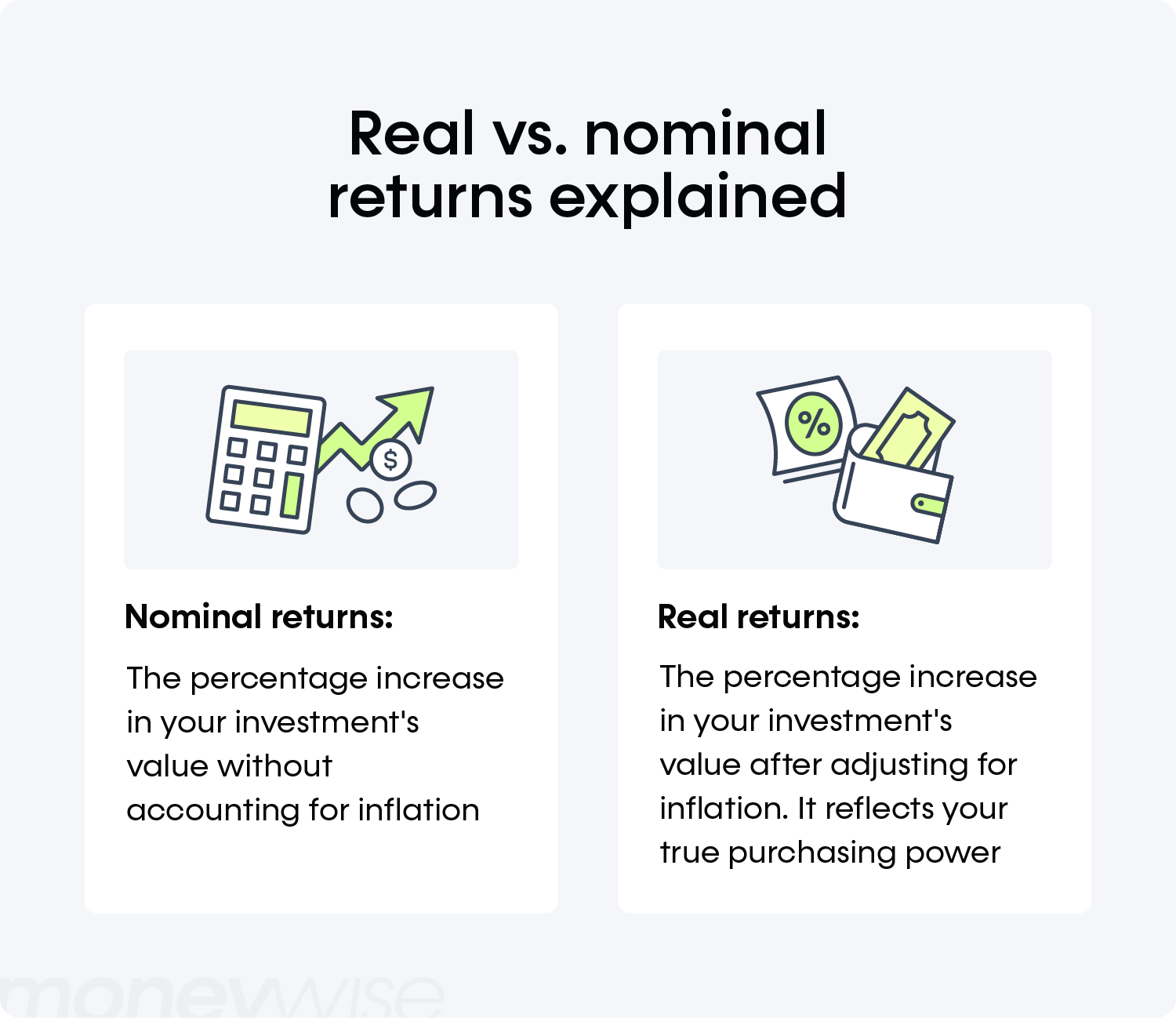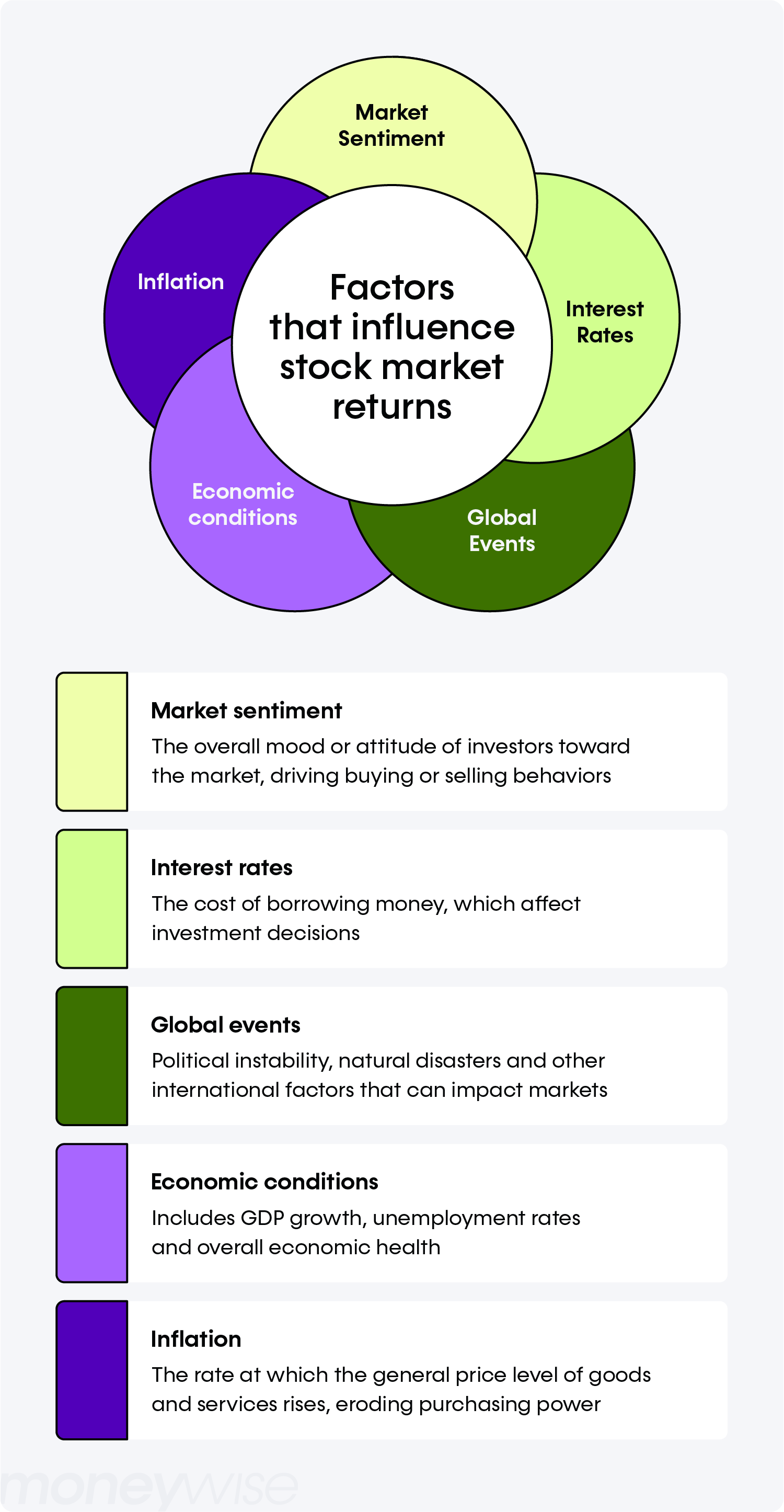Discover the historical average stock market return, factors influencing performance and how to set realistic expectations for your investment portfolio.
The S&P 500 has historically delivered a stock market average return of about 10% before inflation (7% after inflation). However, yearly returns can vary widely, with periods of both higher and lower performance. This helps set realistic expectations and shape long-term strategies.
Historical average stock market return
Understanding historical stock market returns is essential for setting realistic investment expectations and strategies.
The S&P average return of the U.S. stock market has been around 10% annually before adjusting for inflation. However, returns vary significantly across decades, reflecting the impact of economic conditions and major events. It's crucial to remember that while the market has demonstrated long-term growth potential, returns can vary significantly over shorter time horizons.
Nominal vs. real returns
Nominal returns refer to an investment's annual percentage gain or loss without accounting for inflation. In contrast, real returns adjust for inflation and are typically lower than nominal returns.
For example, if you earn a 7% nominal return on your investment, but inflation is 3%, your real return is only 4%. Understanding the difference between these two can help you better assess the true value of your investments.

Impact of market volatility
Historical averages can be misleading because they don’t reveal the year-to-year fluctuations contributing to the average. The market doesn’t grow in a straight line; instead, it goes through periods of gains, known as bull markets, and sharp declines, referred to as bear markets.
Averages often oversimplify long-term investment trends. A decade with a high average return may suggest steady growth but fails to account for extreme highs and lows. This can lead investors to underestimate potential risks or have overly optimistic expectations of future returns.
For example, the 1990s witnessed robust returns fueled by the booming technology sector, while the early 2000s saw a significant downturn following the dot-com bubble.
Understanding the variability behind the average is essential for setting realistic expectations and planning effectively.
Factors that influence returns
Investment returns are influenced by various conditions, including interest rates, inflation, market conditions and investor sentiment. Thoroughly researching the stock market can help you understand these factors and make more informed investment decisions.
"A well-rounded approach includes leveraging financial news, analytical tools, and professional insights to assess how these dynamics influence returns. However, it’s important to remember that at its core, investing in a stock means investing in the underlying business."
Jing Pan, Investment reporter at Moneywise.com

Interest rates and inflation
Inflation refers to the rising cost of goods and services, which erodes purchasing power over time. For instance, if inflation outpaces your investment returns, you may lose money in real terms, even if your investments are growing.
Similarly, interest rates — the cost of borrowing money — can influence economic activity. Higher interest rates make borrowing more expensive, slowing economic growth and reducing consumer spending.
Interest rates and inflation work hand-in-hand and greatly impact how much your investments grow. Investors need to be aware of these factors and consider how they might affect their returns.
Economic conditions
Economic conditions can significantly impact your investment returns. A growing economy typically boosts corporate earnings and consumer spending, driving market growth. In contrast, a slowdown or recession often leads to market declines, reduced business earnings and operational changes.
These shifts can result in higher unemployment rates, signaling low economic activity. Together, these factors shape market trends and influence investment returns.
Global events
Major global events can significantly impact the market, directly affecting your returns. Stock market crashes can occur as a result of events like the global spread of the coronavirus, which caused widespread uncertainty and panic selling.
These events can disrupt supply chains, change consumer behavior and lead to government interventions, all of which can influence market performance. Recognizing the potential effects of such events can help investors make more informed decisions and manage risk.
Market sentiment
Overall market sentiment, the collective attitude of investors, can significantly influence market trends. Sentiment is described as bullish when prices are rising and bearish when prices are falling. Understanding market sentiment can help you gauge potential market movements and adjust your strategies accordingly.
Strategies for using stock market returns in planning
Learn how to leverage stock market returns to create effective strategies for your financial planning, especially if you're getting into stocks now.

Set realistic goals
When planning your financial portfolio timeline, setting realistic and achievable goals is crucial. While you can't control market volatility or guarantee specific returns, a conservative 7%-10% average annual return is a reasonable baseline for long-term projections.
This can help you determine when you might need to sell stock to rebalance your portfolio. Your investment time horizon—how long you plan to invest your money — plays a key role in this planning.
Longer time horizons generally help smooth out market fluctuations and increase your chances of achieving your desired returns. Remember to regularly review and adjust your goals as your financial situation and market conditions change.
"When incorporating historical stock market returns into planning, investors should consider their risk tolerance and how market conditions evolve. While historical returns provide context, they do not guarantee future results, especially during periods of heightened volatility.”
Jing Pan, Investment reporter at Moneywise.com
Create a diverse portfolio
Creating a diverse portfolio is essential for managing investment risk. Diversification means spreading your investments across different types of assets, industries and geographical regions. This strategy helps protect your portfolio from significant losses, as poor performance in one area can be offset by better performance in others.
Mixing stocks, real estate investment trusts (REITs) and bonds helps achieve proper diversification. It’s like not putting all your eggs in one basket—if one investment underperforms, others can help maintain your portfolio’s overall stability.
Understand risk tolerance
Investing always involves some level of risk. Generally, the more you invest, the greater your risk, especially if you focus heavily on one type of investment and reduce your portfolio’s diversification.
Diversification spreads risk across different assets, helping to protect your portfolio from significant losses. Risk tolerance refers to the risk you’re comfortable taking to reach your financial goals.
Be consistent with investing
Consistency is key to helping your investments grow. Consider investing a fixed amount at regular intervals, such as on the first of each month, and build it into your budget. Automating your contributions can make this process easier and help you stay on track toward your financial goals.
Making smart investment decisions with Moneywise
Understanding average stock market returns is crucial for every investor, from beginners to seasoned professionals. While past performance doesn't guarantee future results, staying informed helps you set realistic expectations and make better investment decisions.
Ready to build your investment knowledge? Explore comprehensive resources and tools on Moneywise.com to help guide your financial journey.
FAQs
Below are commonly asked questions about annual stock market returns.

The Moneywise Editorial Team is a group of passionate financial experts, seasoned journalists, and content creators who are deeply committed to providing unbiased, relevant, and accurate financial information. With years of combined industry experience, our team is dedicated to maintaining the highest journalistic standards and delivering informative and engaging content. From personal finance and investing to retirement planning and business finance, we cover a broad range of topics to suit the financial needs of our diverse readership. You can trust the Moneywise Editorial Team to empower you with the knowledge and tools necessary to make wise financial decisions.
Disclaimer
The content provided on Moneywise is information to help users become financially literate. It is neither tax nor legal advice, is not intended to be relied upon as a forecast, research or investment advice, and is not a recommendation, offer or solicitation to buy or sell any securities or to adopt any investment strategy. Tax, investment and all other decisions should be made, as appropriate, only with guidance from a qualified professional. We make no representation or warranty of any kind, either express or implied, with respect to the data provided, the timeliness thereof, the results to be obtained by the use thereof or any other matter. Advertisers are not responsible for the content of this site, including any editorials or reviews that may appear on this site. For complete and current information on any advertiser product, please visit their website.
†Terms and Conditions apply.





